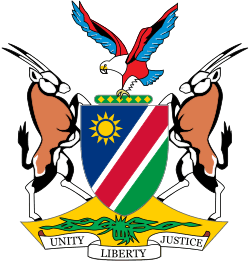Namibian parliamentary election, 1989
 |
| This article is part of a series on the politics and government of Namibia |
Parliamentary elections were held in Namibia between 7 and 11 November 1989. These elections were for the Constituent Assembly of Namibia, which, upon independence in March 1990, became the National Assembly of Namibia.
Background
The elections were facilitated by the United Nations, after the withdrawal of South African troops from South West Africa (present day Namibia) after the 1988 Tripartite Accords. The UN established the United Nations Transition Assistance Group and through its resolutions 629, 632, 640 and 643 in 1989, implemented the United Nations plan for Namibia in 435 (1978) to help secure free and fair elections, and eventually, the country's independence.
701,483 people registered to vote, with 680,788 casting votes, equating to a voter turnout of 97%.
Results
| Parties | Votes | % | Seats |
|---|---|---|---|
| South West African People's Organization | 384,567 | 57.33 | 41 |
| Democratic Turnhalle Alliance | 191,532 | 28.55 | 21 |
| United Democratic Front | 37,874 | 5.65 | 4 |
| Action Christian National | 23,728 | 4.10 | 3 |
| National Patriotic Front | 10,693 | 1.59 | 1 |
| Federal Convention of Namibia | 10,452 | 1.56 | 1 |
| Namibia National Front | 5,344 | 0.80 | 1 |
| SWAPO Democrats | 3,161 | 0.47 | 0 |
| Christian Democratic Action for Social Justice | 2,495 | 0.37 | 0 |
| National Democratic Party | 984 | 0.15 | 0 |
| Invalid/blank votes | 9,958 | - | - |
| Total | 680,788 | 100 | 72 |
| Source: African Elections Database | |||
Aftermath
Following the election, SWAPO supporters celebrated across Windhoek, especially in the segregated suburb of Katutura.[1] Dirk Mudge, chairman of the DTA, pledged to work with the SWAPO government in moving towards independence and national development. Support for the DTA and UDF was strong in the former bantustans including Hereroland and Damaraland.[1]
References
- 1 2 Wren, Christopher S (15 November 1989). "Namibia Rebel Group Wins Vote, But It Falls Short of Full Control". New York Times.
External links
- "Namibian Voters Deny Total Power to SWAPO," by Michael Johns, The Wall Street Journal, November 19, 1989.